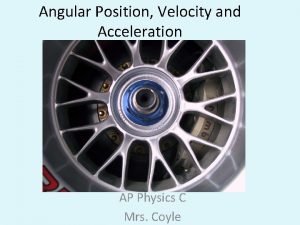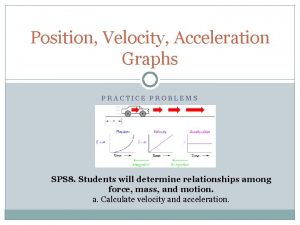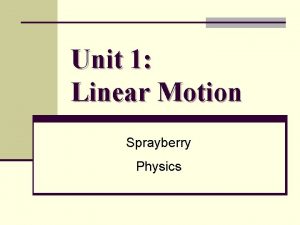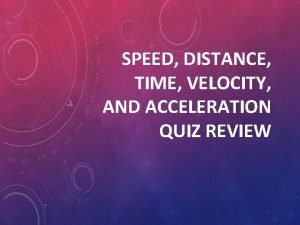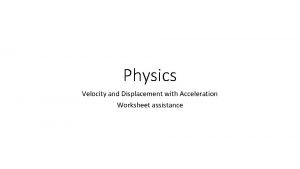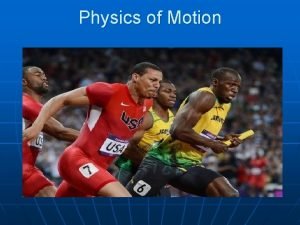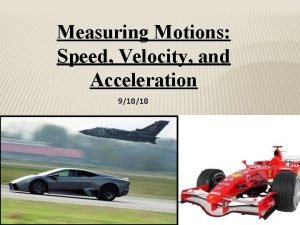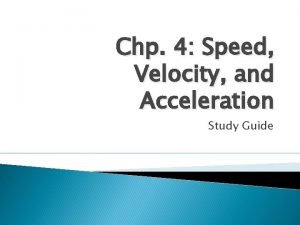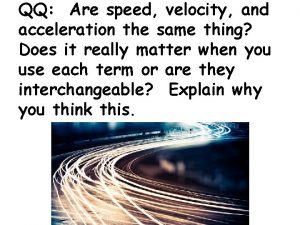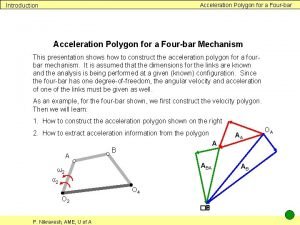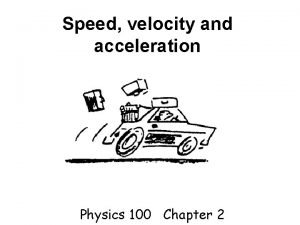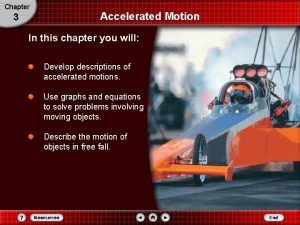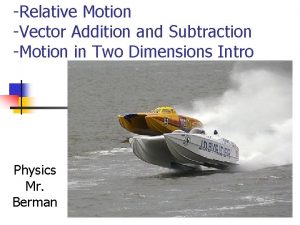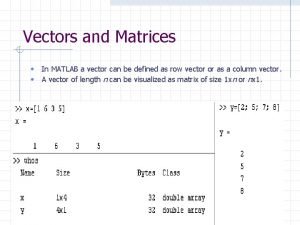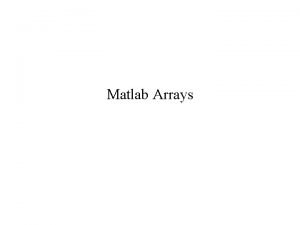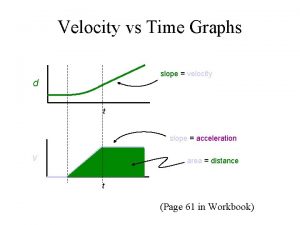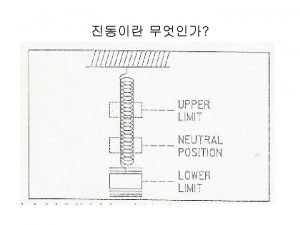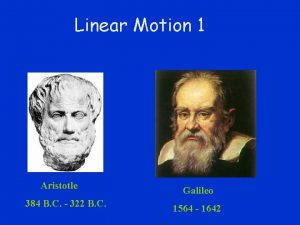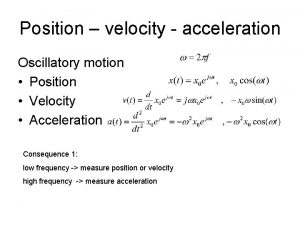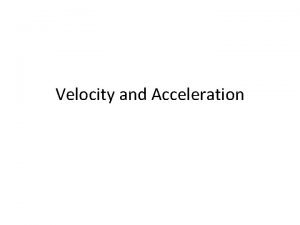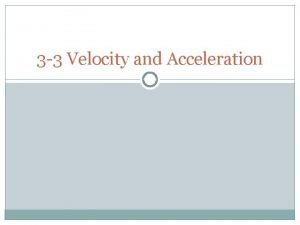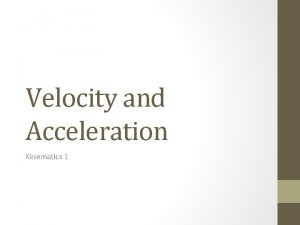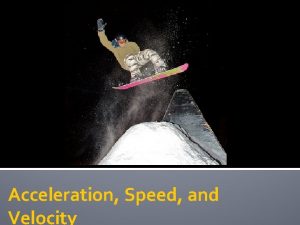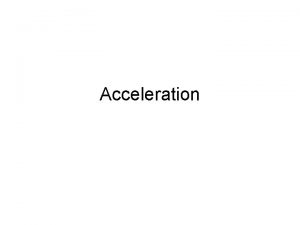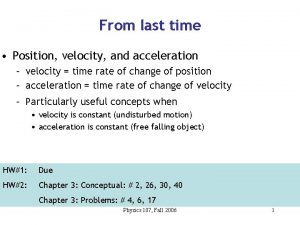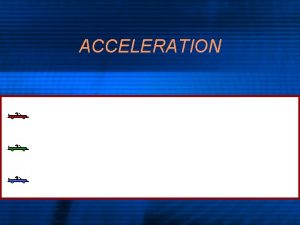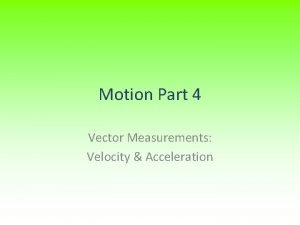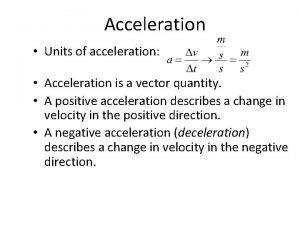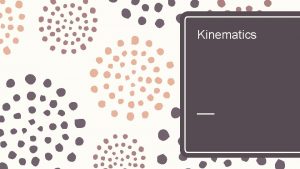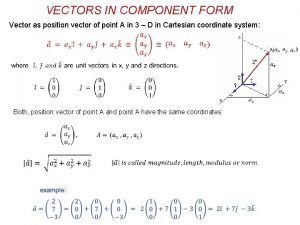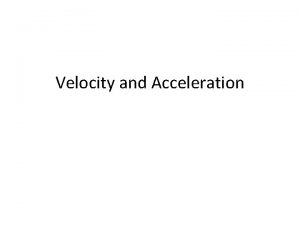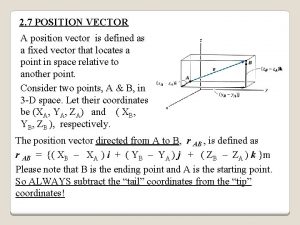Vector Review Unit Vectors Position Velocity and Acceleration







































- Slides: 39

• Vector Review • Unit Vectors • Position, Velocity, and Acceleration Vectors in Multiple Dimensions

Scalars have magnitude only Distance, speed, time, mass Vectors have both magnitude and direction displacement, velocity, acceleration tail R head

The direction of a vector is represented by the direction in which the ray points. This is typically given by an angle. A x

A The magnitude of a vector is the size of whatever the vector represents. The magnitude is represented by the length of the vector. Symbolically, the magnitude is often represented as │A │ If vector A represents a displacement of three miles to the north… B Then vector B, which is twice as long, would represent a displacement of six miles to the north!

Equal vectors have the same length and direction, and represent the same quantity (such as force or velocity).

Inverse vectors have the same length, but opposite direction. A -A

Vectors are added graphically together head-to-tail The sum is called the resultant The inverse of the sum is called the equilibrant B A R A+B=R

1) Resolve each vector into its x and y components Ax = Acos Bx = Bcos Ay = Asin By = Bsin etc. 2) Add the x-components together to get Rx and the y-components to get Ry 3) Use the Pythagorean Theorem to get the magnitude of the resultant 4) Use the inverse tangent function to get the angle.

Sample problem: Add together the following graphically and by component, giving the magnitude and direction of the resultant and the equilibrant. Vector A: 300 m @ 60 o Vector B: 450 m @ 100 o Vector C: 120 m @ -120 o

Polar Angle z Azimuthal Angle az a f ay y ax xy Projection x

z Represented by: (r, Θ, ϕ) rz rx = rsinΘcosϕ ry = rsinΘsinϕ rz = rcosΘ f rx r r = √rx 2 + ry 2 x ϕ = tan-1 (ry/rx) Θ = cos-1 (rz/√rx 2 + ry 2 + rz 2) ry y

Represented by: (r, Θ, z) or (ρ, Θ, z) rx = rcosΘ ry = rsinΘ rz = rz r = √rx 2 + ry 2 Θ = tan-1 (ry/rx) z=z

Unit vectors are quantities that specify direction only. They have a magnitude of exactly one, and typically point in the x, y, or z directions.

z i x k j y

Instead of using magnitudes and directions, vectors can be represented by their components combined with their unit vectors. Example: displacement of 30 meters in the +x direction added to a displacement of 60 meters in the –y direction added to a displacement of 40 meters in the +z direction yields a displacement of: (30 i – 60 j +40 k) m Or <30, -60, 40> m

Simply add: all the i components together all the j components together and all the k components together

Sample problem: Consider two vectors: A = 3. 00 i + 7. 50 j and B = -5. 20 i + 2. 40 j. Calculate C where C = A + B. Sample problem: You move 10 meters north and 6 meters east. You then climb a 3 meter platform, and move 1 meter west on the platform. What is your displacement vector? (Assume East is in the +x direction).

Given the vector

Consider two vectors: A = 3. 00 i + 7. 50 j and B = -5. 20 i + 2. 40 j. Calculate C where C = A + B. Find the magnitude and direction of C You move 10 meters north and 6 meters east. You then climb a 3 meter platform, and move 1 meter west on the platform. What is your displacement vector? (Assume East is in the +x direction). Find the magnitude and direction of the displacement

x: position x: displacement v: velocity a: acceleration n In Unit Vector Notation n r: position r: displacement v: velocity a: acceleration r=xi+yj+zk r = x i + y j + z k v = vx i + vy j + vz k a = a x i + a y j + az k

The position of a particle is given by: r = (80 + 2 t)i – 40 j - 5 t 2 k. • Derive the velocity and acceleration vectors for this particle. • What does motion “look like”?

A position function has the form r = x i + y j where x = t 3 – 6 and y = 5 t – 3. • Determine the velocity and acceleration functions. • Determine the velocity and speed at 2 seconds.

Multi-Dimensional Motion with Constant (or Uniform) Acceleration

A baseball outfielder throws a long ball. The components of the position are x = (30 t) m and y = (10 t – 4. 9 t 2) m • Write vector expressions for the ball’s position, velocity, and acceleration as functions of time. Use unit vector notation! • Write vector expressions for the ball’s position, velocity, and acceleration at 2. 0 seconds.

A particle undergoing constant acceleration changes from a velocity of 4 i – 3 j to a velocity of 5 i + j in 4. 0 seconds. • What is the acceleration of the particle during this time period? • What is its displacement during this time period?

g g g This shows the parabolic trajectory of a projectile fired over level ground. Acceleration points down at 9. 8 m/s 2 for the entire trajectory.

vx vy vx vx vy The velocity can be resolved into components all along its path. Horizontal velocity remains constant; vertical velocity is accelerated.

…resolve the initial velocity into components. Vo, x = Vo cos Vo, y = Vo sin

y x t t

Vy Vx t t

ay ax t t

A soccer player kicks a ball at 15 m/s at an angle of 35 o above the horizontal over level ground. How far horizontally will the ball travel until it strikes the ground?

A cannon is fired at 20 m/s at an angle of 15 o above the horizontal from the top of a 120 m high cliff. How long will it take the cannonball to strike the plane below the cliff? How far from the base of the cliff will it strike?

A day of derivations

Sample problem: derive the trajectory equation.

Sample problem: Derive the range equation for a projectile fired over level ground.

Sample problem: Show that maximum range is obtained for a firing angle of 45 o.

Will the projectile always hit the target presuming it has enough range? The target will begin to fall as soon as the projectile leaves the gun.

Purpose: Using only a stopwatch, a football field, and a meter stick, determine the launch velocity of sports projectiles that you punt, pass, or kick. Theory: Use horizontal (unaccelerated) motion to determine Vx, and vertical (accelerated) motion to determine Vy. Ignore air resistance. Data: Prepare your lab book to collect xi, xf, yo, and t measurements for each sports projectile. Analyze the data fully for at least three trials. Make sure you dress comfortably tomorrow!
 Is v final velocity
Is v final velocity Constant acceleration speed time graph
Constant acceleration speed time graph Angular acceleration unit
Angular acceleration unit What does constant acceleration mean
What does constant acceleration mean Ballet terms and positions
Ballet terms and positions Linear acceleration vs tangential acceleration
Linear acceleration vs tangential acceleration Linear acceleration vs tangential acceleration
Linear acceleration vs tangential acceleration Tangential acceleration and centripetal acceleration
Tangential acceleration and centripetal acceleration How to find the unit vector
How to find the unit vector Unit 10, unit 10 review tests, unit 10 general test
Unit 10, unit 10 review tests, unit 10 general test What is the difference between velocity and acceleration
What is the difference between velocity and acceleration Velocity
Velocity Speed velocity and acceleration quiz
Speed velocity and acceleration quiz Speed, velocity and acceleration problems
Speed, velocity and acceleration problems What is relative acceleration
What is relative acceleration Displacement and velocity worksheet
Displacement and velocity worksheet Difference between velocity and acceleration
Difference between velocity and acceleration Speed, velocity, and acceleration
Speed, velocity, and acceleration A cart slows down while moving away from the origin
A cart slows down while moving away from the origin 21bwundoqno -site:youtube.com
21bwundoqno -site:youtube.com Speed velocity and acceleration study guide answers
Speed velocity and acceleration study guide answers Velocity polygon analysis
Velocity polygon analysis Describes both speed and direction
Describes both speed and direction Are speed and acceleration the same thing
Are speed and acceleration the same thing What is acceleration
What is acceleration Velocity and acceleration quick check
Velocity and acceleration quick check Velocity polygon
Velocity polygon Velocity and speed
Velocity and speed Formula of km/h
Formula of km/h Physics chapter 3 accelerated motion test
Physics chapter 3 accelerated motion test Adding velocity vectors
Adding velocity vectors How to find centripetal acceleration
How to find centripetal acceleration Radial acceleration definition
Radial acceleration definition Initial velocity and final velocity formula
Initial velocity and final velocity formula Matlab vector of vectors
Matlab vector of vectors Matlab
Matlab Constant leftward velocity
Constant leftward velocity Derivatives of position
Derivatives of position Vibration displacement velocity acceleration
Vibration displacement velocity acceleration Negative velocity negative acceleration
Negative velocity negative acceleration


